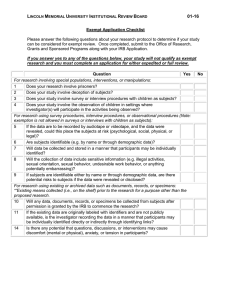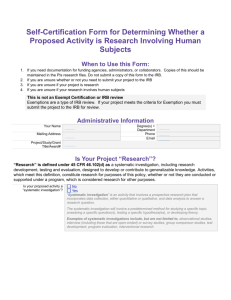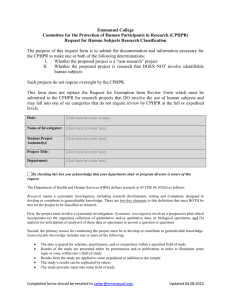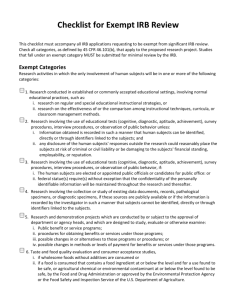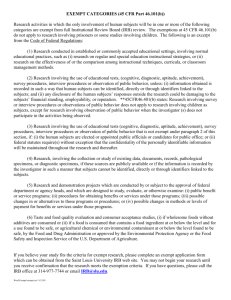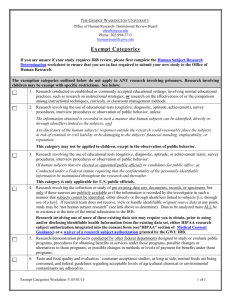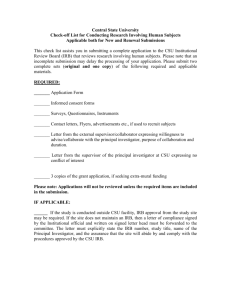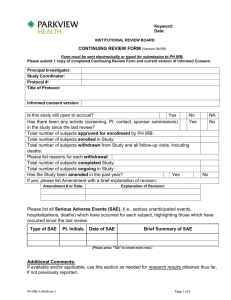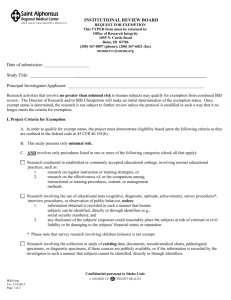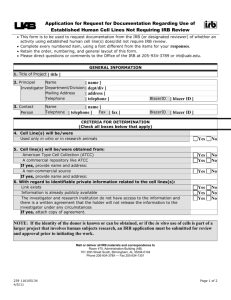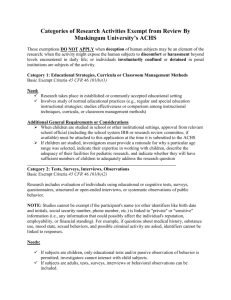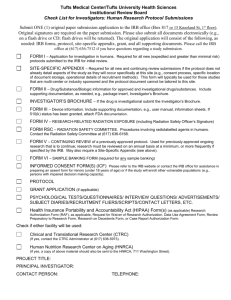POLICIES - CoxHealth
advertisement
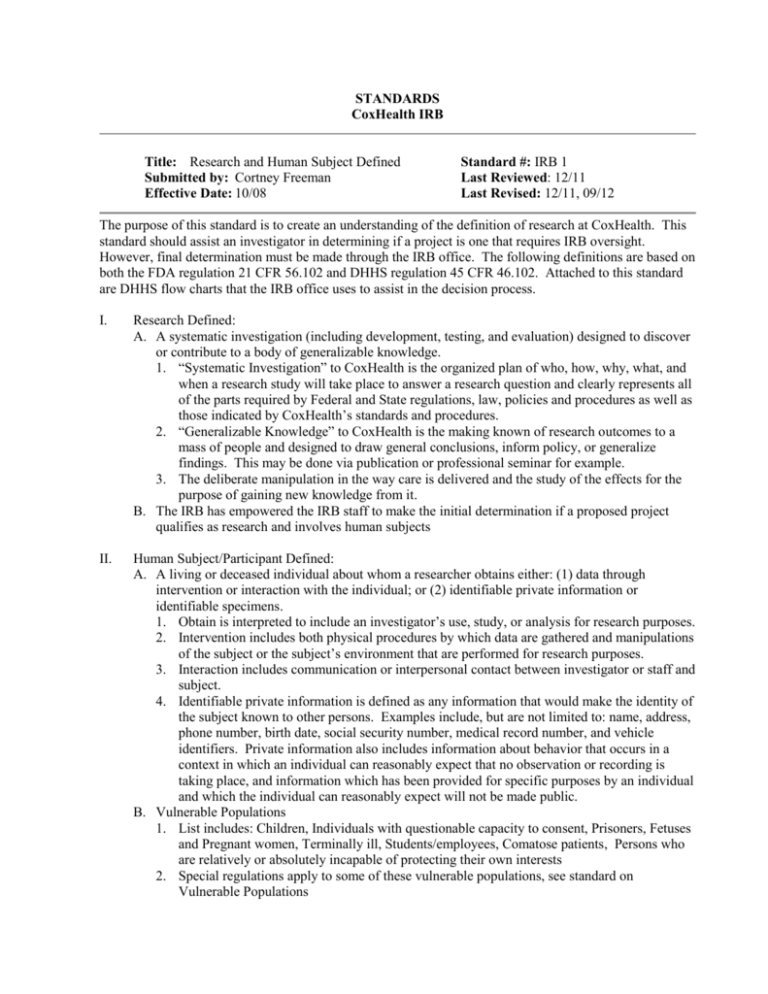
STANDARDS CoxHealth IRB Title: Research and Human Subject Defined Submitted by: Cortney Freeman Effective Date: 10/08 Standard #: IRB 1 Last Reviewed: 12/11 Last Revised: 12/11, 09/12 The purpose of this standard is to create an understanding of the definition of research at CoxHealth. This standard should assist an investigator in determining if a project is one that requires IRB oversight. However, final determination must be made through the IRB office. The following definitions are based on both the FDA regulation 21 CFR 56.102 and DHHS regulation 45 CFR 46.102. Attached to this standard are DHHS flow charts that the IRB office uses to assist in the decision process. I. Research Defined: A. A systematic investigation (including development, testing, and evaluation) designed to discover or contribute to a body of generalizable knowledge. 1. “Systematic Investigation” to CoxHealth is the organized plan of who, how, why, what, and when a research study will take place to answer a research question and clearly represents all of the parts required by Federal and State regulations, law, policies and procedures as well as those indicated by CoxHealth’s standards and procedures. 2. “Generalizable Knowledge” to CoxHealth is the making known of research outcomes to a mass of people and designed to draw general conclusions, inform policy, or generalize findings. This may be done via publication or professional seminar for example. 3. The deliberate manipulation in the way care is delivered and the study of the effects for the purpose of gaining new knowledge from it. B. The IRB has empowered the IRB staff to make the initial determination if a proposed project qualifies as research and involves human subjects II. Human Subject/Participant Defined: A. A living or deceased individual about whom a researcher obtains either: (1) data through intervention or interaction with the individual; or (2) identifiable private information or identifiable specimens. 1. Obtain is interpreted to include an investigator’s use, study, or analysis for research purposes. 2. Intervention includes both physical procedures by which data are gathered and manipulations of the subject or the subject’s environment that are performed for research purposes. 3. Interaction includes communication or interpersonal contact between investigator or staff and subject. 4. Identifiable private information is defined as any information that would make the identity of the subject known to other persons. Examples include, but are not limited to: name, address, phone number, birth date, social security number, medical record number, and vehicle identifiers. Private information also includes information about behavior that occurs in a context in which an individual can reasonably expect that no observation or recording is taking place, and information which has been provided for specific purposes by an individual and which the individual can reasonably expect will not be made public. B. Vulnerable Populations 1. List includes: Children, Individuals with questionable capacity to consent, Prisoners, Fetuses and Pregnant women, Terminally ill, Students/employees, Comatose patients, Persons who are relatively or absolutely incapable of protecting their own interests 2. Special regulations apply to some of these vulnerable populations, see standard on Vulnerable Populations III. Examples of research that involves Human Subjects A. Study of tissue specimen, medical records, genetic material, behavioral and/or biomedical assessments, and treatments B. Legal obligations to protect also applies to research that uses: 1. Bodily materials, such as cells, blood or urine, organs, and hair or nail clippings, even if the researcher didn’t collect these materials 2. Residual diagnostic specimens, including specimens obtained for routine patient care that would have been discarded if not used for research 3. Private information, such as medical data, that can be readily identified with individuals, even if the information was not specifically collected for the study IV. Examples of research that are not considered Human Subject Research A. Data collection for internal purposes, such as a customer service survey B. Quality improvement projects are generally not considered research unless there is a clear intent to contribute to generalizable knowledge and use the data derived from the project to improve or alter the quality of care or the efficiency of institutional practice outside of CoxHealth. C. Information-gathering interviews where questions focus on things, products, or policies rather than on people. V. Quality Improvement A. A procedure applied in practice, designed to enhance the well being of particular individuals or groups rather than to produce generalizable knowledge. Generally, focus is on a process more than individual. B. Such work can and should be seen as research if the initial improvement plan contains formal elements designed specifically to generate new generalizable knowledge, over and above its intended immediate benefit to its local participants. VI. Determining if proposed Protocol constitutes human subject research and/or exemption from regulations A. The Office for Human Research Protections (OHRP) provides the attached flow charts to clarify portions of the Department of Health and Human Services (DHHS) human subject regulations at Title 45 CFR 46. The IRB office has been authorized and instructed to use this 2 step flow chart system to aid in the determination of when something is considered research with human subjects and when it is exempt from IRB review. They are not designed to be used exclusively. B. A series of questions may also be referenced to determine if research involves human subject 1. Is the activity in investigation? (Investigation: a searching inquiry for facts; detailed or careful examination.) 2. Is the investigation systematic? (Systematic: having or involving a system, method, or plan.) 3. Is the systematic investigation designed to develop or contribute to knowledge? (Designed: evaluate whether the activities will develop or contribute to knowledge. Develop: to form the basis for a future contribution. Contribute: to result in. Knowledge: truths, facts, information.) 4. Is the knowledge the systematic investigation is designed to develop or contribute generalizable? (Generalizable: universally or widely applicable.) 5. If all the above are a yes, then the investigation is research and a determination must be made if it involves human subjects. 6. Will the investigator gather information through either of the following mechanisms? a. Physical procedures or manipulations of those individuals or their environment (“intervention”). b. Communication or interpersonal contact with the individuals (“interaction”). 7. Will the investigator gather data that is about behavior that occurs in context in which an individual can reasonably expect that no observation or recording is taking place (i.e. “private information”)? 8. OR will the investigator gather data that individuals have provided for specific purposes in which the individuals can reasonably expect that it will NOT be made public, such as a medical record? 9. Can the individual’ identities be readily ascertained or associated with the information by the investigator (i.e. “identifiable information”)? This does not mean identifiable information can not be used to gather the data. 10. If #6 or a combination of #7 or #8 and #9 is yes, then human subjects are involved and the study must be reviewed by the IRB. Chart 1: Definition of Human Subject at Section 46.102(f) Is there an intervention or an interaction with a living person that would not be occurring or would be occurring in some other fashion, but for this research? Yes No Will identifiable private data/information be obtained for this research in a form associable with the individual? Yes Human subjects are involved; is the research exempt? No This is not research on human subjects. IRB approval not required. Chart 2: Exemption at Section 46.101(b)(4) regarding research involving the collection or study of existing data, documents, records, pathological specimens, or diagnostic specimens. The following chart will help to identify if the research is exempt through the above noted exemption. Will this research use solely existing data or specimens? Yes No Are those data or specimens publicly available? Yes No Will information be recorded by the investigator in such a way that it can be linked to the subject? No This research is exempt from review. Yes This research is not exempt from review under 45 CFR Part 46.
